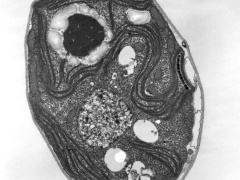Features
Concentrating on photosynthesis
Date: 2019-08-30 10:55:58.0
Author: Jon Evans

Chlamydomonas reinhardtii.
Image: RIPE.
Last year, a team of Australian scientists developed an artificial version of a cellular compartment known as a carboxysome, which is found in cyanobacteria, as a way to boost the productivity of food crops (see Putting the carboxysome in crop plants). Carboxysomes are critical components of the carbon dioxide concentration mechanism (CCM), which cyanobacteria and green algae use to enhance the efficiency of photosynthesis. It works by increasing the concentration of carbon dioxide around the enzyme Rubisco (ribulose-1,5-bisphosphate carboxylase/oxygenase), which performs the first step in converting carbon dioxide into sugars.
Rubisco is located in the chloroplasts of all photosynthesizing organisms, but it doesn’t work very efficiently in most terrestrial plants. This is both because carbon dioxide diffuses passively into and out of the plant cell, meaning it’s never present in the chloroplast at very high concentrations, and because oxygen competes with carbon dioxide for access to Rubisco. As photosynthesizing aquatic organisms, however, cyanobacteria and algae have both evolved versions of the CCM, which takes a slightly different approach.
For a start, any carbon dioxide entering cyanobacteria or algae cells is immediately converted into bicarbonate, which cannot simply diffuse into and out of the cell. This bicarbonate is then transported to Rubisco-containing compartments within the chloroplast, known as carboxysomes in cyanobacteria and pyrenoids in green algae, where an enzyme called carbonic anhydrase converts the bicarbonate back into carbon dioxide. Any carbon dioxide that escapes from the carboxysome or pyrenoid is simply converted to bicarbonate again and transported back. In this way, carbon dioxide is concentrated around Rubisco, enhancing its efficiency.
The development of a simplified, artificial carboxysome was the first step in efforts by scientists to introduce the CCM into crop plants, as a way to enhance their productivity. Now, a team from the UK and the US has taken the next step, by identifying the protein transporters responsible for delivering bicarbonate to the pyrenoids in a species of green algae known as Chlamydomonas reinhardtii.
Because bicarbonate can’t just diffuse through cellular membranes, it has to be actively carried through by protein transporters. Scientists have identified the transporters responsible for carrying bicarbonate from the main cell into the chloroplast and then into the chloroplast stroma. But they didn’t know how the bicarbonate was transported from the stroma into a compartment known as the thylakoid, which passes through pyrenoids.
By looking for genes in C. reinhardtii that are upregulated in low-carbon dioxide conditions, the scientists, led by Luke Mackinder at the University of York, found three very likely candidates, termed BST1, BST2 and BST3. When they knocked out the genes for just one of these transporters, however, they found it didn’t have much effect on the algae’s ability to photosynthesize and grow. When they knocked out all three, on the other hand, it had a major effect.
As the scientists report in a paper in the Proceedings of the National Academy of Sciences, this implies the CCM is so important to algae that there is a built-in redundancy. That is why there are three separate protein transporters for taking bicarbonate across the thylakoid membrane.
Mackinder and his team think that the bicarbonate is actually converted into carbon dioxide in the thylakoid, from where it simply diffuses into the pyrenoid. But if these protein transporters can be combined with the artificial carboxysome, then if offers a pathway to replicating the CCM in crop plants.
"While other transport proteins are known, we speculate that these could be shared with crops more easily because Chlamy [C. reinhardtii] is more closely related to plants than other photosynthetic algae, such as cyanobacteria or diatoms," said Mackinder.
He will soon get the chance to find out, thanks to a grant from the US National Science Foundation and the UK's Biotechnology and Biological Sciences Research Council. This was recently awarded to Mackinder and groups from the universities of Cambridge and Edinburgh in the UK, and Princeton University in the US, so they can try to create a functional pyrenoid in the model plant Arabidopsis thaliana.
The views represented here are solely those of the author and do not necessarily represent those of John Wiley and Sons, Ltd. or of the SCI.
Displaying 2 keywords used to tag this article:
- DG6582 Mens Moncler Down Jackets Gr
- Jules Audemars-Australia Best Quali
